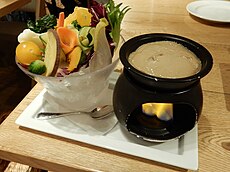Bagna càuda
 Bagna càuda is kept hot by a small heat source below the dish. | |
| Type | Dip |
|---|---|
| Place of origin | Italy |
| Region or state | Piedmont |
| Associated national cuisine | Italian |
| Main ingredients | Garlic, anchovies, olive oil |
Bagna càuda (Piedmontese: [ˈbɑɲa ˈkɑʊ̯da], meaning "hot dip", "hot gravy")[1] is a hot dish made from garlic and anchovies, originating in Piedmont, Italy during the 16th century. The dish is served and consumed in a manner similar to fondue, sometimes as an appetizer, with raw or cooked vegetables typically used to dip into it.[2]
Overview[]
Bagna càuda is a hot dish and dipping sauce in Italian cuisine that is used to dip vegetables in.[3][4] It is prepared using olive oil, chopped anchovies and garlic.[3][4] Additional ingredients sometimes used include truffle and salt.[3] Raw or cooked vegetables are dipped into the sauce, which is typically kept hot on a serving table using a heat source such as a candle or burner.[3]
Bagna càuda originates from and has been described as "unique to" Piedmont, a Northwest Italy region, and has been a part of Piedmontese cuisine since the 16th century.[3][5] In Piedmont, cardoon (edible thistle) is often dipped in the sauce.[3] Additional foods used to dip into it include cabbage, celery, carrots, artichoke, peppers, fennel and breads.[3][6] It is sometimes served as an appetizer.[7][8]
It is also a popular winter dish in central Argentina[9][10] and prevalent in Clinton, Indiana, Rock Springs, Wyoming, and Benld, Illinois, United States,[11] as there were many northern Italian immigrants to those places.[12] Bagna càuda was also prepared in the coal mining community of Madison County, Illinois [13] (including Collinsville,[14] Edwardsville, and Maryville, Illinois) due to the numerous Italian immigrants that came there to work in the mines.

History[]
In the past walnut or hazelnut oil would have been used.[15] Sometimes, truffles are used in versions around Alba, Piedmont, Italy.[16] It is traditionally eaten during the autumn and winter months, particularly at Christmas and New Year's, and must be served hot, as the name suggests.
Similar dishes[]
Pinzimonio is a similar dipping sauce prepared using olive oil, wine vinegar, salt and pepper that is served with raw vegetables.[5][17] It is typically served cold.[18]
See also[]
- List of Italian dishes
- List of dips
- List of garlic dishes
- List of hors d'oeuvre
References[]
- ^ "bagna". Grande Dizionario Piemontese Olivetti. Retrieved 24 January 2021.
- ^ La Cucina Italiana 2008, s.v.
- ^ Jump up to: a b c d e f g Root, W. (1992). The Food of Italy. Vintage Books. pp. 319–320. ISBN 978-0-679-73896-1. Retrieved January 4, 2018.
- ^ Jump up to: a b Sinclair, C.G. (1998). International Dictionary of Food and Cooking. Fitzroy Dearborn. p. 44. ISBN 978-1-57958-057-5. Retrieved January 4, 2018.
- ^ Jump up to: a b Western Pennsylvania History. Historical Society of Western Pennsylvania. 1999. p. 167. Retrieved January 4, 2018.
- ^ Los Angeles Magazine. Los Angeles Magazine. 2008. p. 114. Retrieved January 4, 2018.
- ^ Buckley, Chris (November 27, 2012). "Iconic Charleroi eatery – Rego's – changes hands". TribLIVE.com. Retrieved January 4, 2018.
- ^ Waters, A.L. (2014). Chez Panisse Cafe Cookbook. Chez Panisse (in French). HarperCollins. p. 16. ISBN 978-0-06-235400-6. Retrieved January 4, 2018.
- ^ McCloskey, E.; Ainsley, R.; Eder, T. (2011). Argentina: The Bradt Travel Guide. Bradt Guides. Bradt Travel Guides. p. 388. ISBN 978-1-84162-351-1. Retrieved January 4, 2018.
- ^ Books, Madison; Andrews McMeel Publishing, LLC; Kummer, C. (2007). 1001 Foods To Die For (in German). Andrews McMeel Publishing. p. 16. ISBN 978-0-7407-7043-2. Retrieved January 4, 2018.
- ^ Zelinsky, Wilbur (2001). The Enigma of Ethnicity: Another American Dilemma. NONE Series. University of Iowa Press. p. 120. ISBN 978-1-58729-339-9. Retrieved January 4, 2018.
- ^ Calvitto, C. (2007). Searching for Italy in America's Rural Heartland. Vantage Press. p. 2. ISBN 978-0-533-15737-2. Retrieved January 4, 2018.
- ^ Hillig, Terry. Miners’ heritage is on display in Collinsville. St. Louis Post-Dispatch. September 22, 2010. Retrieved July 28, 2021.
- ^ Starkey, Roger. Collinsville Sunrise Kiwanis: Selling bagna cauda and peanuts for a better Christmas. The Metro Independent. September 12, 2014. Retrieved July 28, 2021.
- ^ Paolo Massobrio, ‘Il rito della Bagnacauda’ Archived July 22, 2011, at the Wayback Machine, a+, December 2004.
- ^ Hesser, Amanda (November 5, 2009). "Bagna Cauda, 1960". New York Times. p. MM20, New York edition. Retrieved March 8, 2010.
- ^ Darrow, D.; Maresca, T. (2012). The Seasons of the Italian Kitchen. Grove/Atlantic, Incorporated. p. pt185. ISBN 978-0-8021-9341-4. Retrieved January 4, 2018.
- ^ Vivian, C.; Sansone, V.P. (2011). Tuscan-American Kitchen, A (in German). Pelican Pub. Company. p. 93. ISBN 978-1-58980-906-2. Retrieved January 4, 2018.
External links[]
 Media related to Bagna càuda at Wikimedia Commons
Media related to Bagna càuda at Wikimedia Commons The dictionary definition of bagna càuda at Wiktionary
The dictionary definition of bagna càuda at Wiktionary
- Cuisine of Piedmont
- Italian cuisine
- Dips (food)
- Anchovy dishes
- Fish sauces
- Garlic dishes
